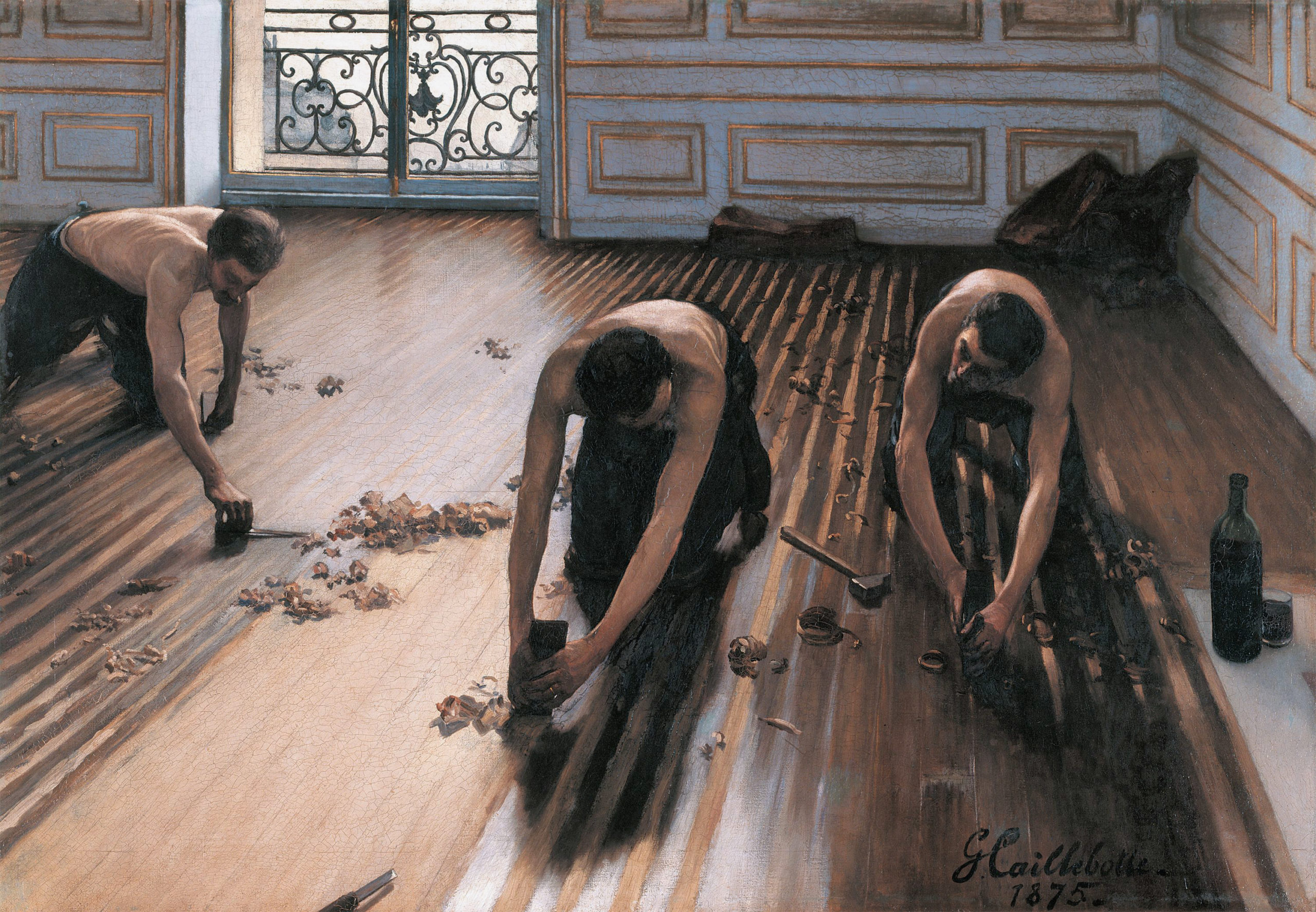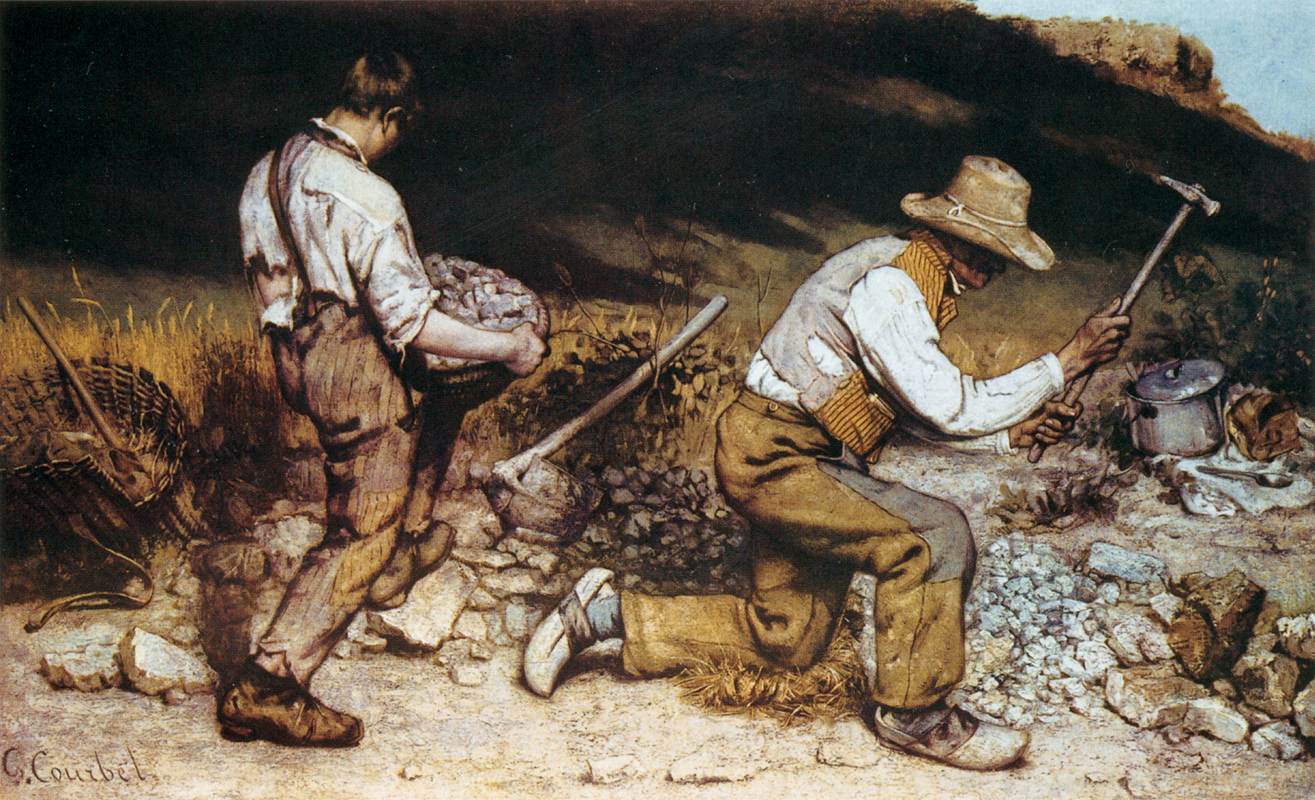/The Floor Scrapers
Analysis of Gustave Caillebotte's Masterpiece
from 08/05/2024, by uni — 6m read

Figure 1
Originally committed to practicing law in Paris, Gustave Caillebotte began to seriously pursue painting after serving in the Franco-Prussian War. Born into an affluent family, Caillebotte didn't have to subject himself into a life of labor. As the heir to a French government contractor, his wealth enabled him to purchase works from his contemporaries, and he became an important patron and supporter of the Impressionists. He atteneded the First Impressionist Exhibition of 1874, which he was also partly responsible for organizing and funding. It was around this same time that Caillebotte started creating some of his most famous works, including Les raboteurs de parquet (English title: The Floor Scrapers).
Gustave Caillebotte found himself in an uncomfortable position, self-conscious about his social class and uncertain about his life's vocation. Frustrated with his comfortable life, he was nevertheless able to focus on the integrity of his work without the need to pursue commercial success. His first major painting, Les Raboteurs de parquet (fig. 1), reflects an attempt to reconcile the consequences of his inherited wealth, the labor of others from which it was derived, and his deep-seated desire to be something more than a leisured bourgeois. Clearly, he wanted to offer something back to the world rather than merely benefiting from it.

Figure 2
It was significant when oil painters began depicting the urban working class, moving away from their traditional focus on the wealthy, the church, the government, and commissioned works. It was much more common to see paintings of the rural proletariat, such as Gustave Courbet’s The Stonebreakers (fig. 2). In his work, Caillebotte depicts three laborers on their hands and knees scraping the floors in an unfurnished yet ornate Parisian apartment, which belonged to Caillebotte himself. The tilted, conversing heads of the two workers on the right suggest a sense of friendship or camaraderie. Their naked torsos highlight their anatomy, with sunlight streaming through the top left window emphasizing the sinews and muscles of their arms. The leftmost worker exudes more intense concentration in his work and is the only one with a personal vice, a cigarette. All three workers are turned away from the white molded wall with gold trimming, perhaps suggesting that this kind of luxury was out of their reach. The contrast between the opulent walls and their everyday clothing, discarded messily in the back right corner of the room, underscores the disparity between their labor and the environment they work in. In the left foreground, an open bottle of wine and a glass are depicted, a common sight among the Parisian working class.
.jpg)
Figure 3
However, the perspective of the painting hides its most important detail, identities of the workers. This forced perspective and photographic-like framing, capturing a moment with seemingly random composition, keeps the viewer's and painter's vision grounded, mirroring the workers and their condition. Perhaps Caillebotte illustrates the feeling of alienation from the workers, as he is standing over them both literally and figuratively, emphasizing the social class divide. Unlike his other interior paintings, such as Jeune homme au piano (English title: Young Man Playing the Piano) and Jeune homme à sa fenêtre (English title: Young Man at His Window) (fig. 3), which invite the viewer to look outside of the windows, this painting locks the viewer within the room itself. It is as if Caillebotte is forcing himself to experience life as a commoner, instead of his priviledged dilettante lifestyle, which included yacht building and racing. This form of self-punishment reflects his discomfort with his own social status and his desire to bridge the gap between his world and that of the laborers.
"I am a realist painter. I try to depict contemporary life." - Gustave Caillebotte
Dissecting his work further, it's apparent that the motif of curls within the painting adds to the narrative. The cast-iron curls in the window, the arches of the men's backs, and the curls of the wood shavings themselves all form spirals that represent the lives of these workers. They continuously push their bodies to wake up, work, and sleep, literally scraping by in life. Life for them is monotonous yet endless. They live in an uncomfortable transition period in the world after industrialization but before modernization. While their kind would eventually dwindle, inevitably, they will continue to scrape. Critics' reactions at the time were concerning. Novelist Émile Zola remarked that Caillebotte's work was "so accurate that it made it bourgeois." But isn't that exactly the point of The Floor Scrapers? To Caillebotte, this is an unaltered depiction of contemporary life, which he feels it is his duty to present accurately.
Though not a social justice activist, Caillebotte chose to paint the world as he saw it, unfiltered and raw. His privileged background, which afforded him luxurious apartments, yachts, and ample leisure time, allowed him to create art free from commercial pressures. This financial independence enabled Caillebotte to produce works that were deeply personal, reflecting his inner thoughts and struggles. As such, his name deserves to stand alongside renowned contemporaries like Renoir, Monet, and Degas. "The Floor Scrapers" serves as a canvas for Caillebotte's internal conflict, portraying his guilt over inherited wealth and his attempt to reconcile a life of comfort with the harsh realities of labor. A sense of alienation permeates the work, evident not only in the depiction of the workers but also in Caillebotte's position as an unseen observer. By focusing on the workers' physicality and juxtaposing it against the ornate surroundings, Caillebotte elevates their labor to a subject worthy of artistic merit while highlighting the societal disparities he acutely felt.